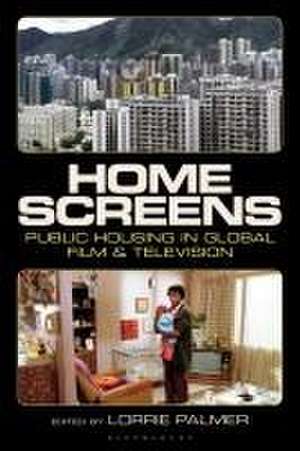Home Screens: Public Housing in Global Film & Television
Editat de Lorrie Palmeren Limba Engleză Hardback – 13 dec 2023
Preț: 512.87 lei
Preț vechi: 732.64 lei
-30% Nou
Puncte Express: 769
Preț estimativ în valută:
98.15€ • 101.39$ • 81.69£
98.15€ • 101.39$ • 81.69£
Carte disponibilă
Livrare economică 04-18 martie
Preluare comenzi: 021 569.72.76
Specificații
ISBN-13: 9781350253957
ISBN-10: 1350253952
Pagini: 296
Ilustrații: 24 bw illus
Dimensiuni: 156 x 234 mm
Greutate: 0.64 kg
Editura: Bloomsbury Publishing
Colecția Bloomsbury Academic
Locul publicării:London, United Kingdom
ISBN-10: 1350253952
Pagini: 296
Ilustrații: 24 bw illus
Dimensiuni: 156 x 234 mm
Greutate: 0.64 kg
Editura: Bloomsbury Publishing
Colecția Bloomsbury Academic
Locul publicării:London, United Kingdom
Caracteristici
Features essays by international scholars of film and media, sociology, architecture, history, race, class, gender and urban planning
Notă biografică
Lorrie Palmer is Associate Professor of Film and Media Studies at Towson University, USA. She has published widely on film history, digital aesthetics, race, gender and technology in film and television, genre, and cinematic urban architecture.
Cuprins
Introduction: Public housing in global film and television - Lorrie Palmer I: Design, architecture and space 1. Uncanny architecture: Haunted structures in Candyman and The Pruitt-Igoe Myth - Lorrie Palmer2. Die architekten (1990): East/west ideology, concrete topography and the shadow of plattenbau - Heike Kumpf and Kirsten Kumpf Baele 3. Architect and amateur documentarian, Yitzhak Perlstein: Planning Israeli public housing (1960-70) - Daphna Levine and Liat Savin Ben Shoshan 4. Pier Paolo Pasolini's Mamma Roma (1962): INA-Casa public housing and remaking Rome's postwar social landscape - Alberto Lo Pinto5. Aerial transitions: Drones and domestic space in the Banlieue - Isabelle McNeillII: Spatialization of race, class and gender 6. Precarious homes in Britain and France - girlhood, escape and dance in Fish Tank and Divines - Anna Viola Sborgi 7. Cooley High, Cabrini-Green and early-onset rusting in Chicago - Michael D. Dwyer8. Franklin Wong's Below the Lion Rock television series: Community dialogue in 1970s Hong Kong public housing - Chung-kin Tsang9. Within the public housing flats: Interiorization of class drama in Singapore cinema - Meisen Wong and Chua Beng HuatIII: Home screens: Public housing in serialized television drama of The Wire, Treme, and Show Me a Hero10. Ignoring women and communities of care: Public housing in The Wire - Kalima Young11. 'People need to come home': Treme, Abandoned housing and post-Katrina New Orleans - Helen Morgan Parmett12. Public housing, social problems and defensible space in David Simon's show me a hero - Steve MacekFurther ViewingIndex
Recenzii
This wide-ranging and very necessary volume grapples with what it means for public housing to become an image. Across twelve strikingly argued chapters, Palmer and her contributors show how film and television not only materially contribute to that image on a global scale, but how they can iterate, complicate, or question it and, in doing so, redefine our image of the home.
Home Screens is a must read for anyone interested in government-financed housing in both material reality and cinematic space. Palmer and her contributors deftly examine how diverse tenants try to create a sense of "home" in its contained, often precarious spaces.
Home Screens is a must read for anyone interested in government-financed housing in both material reality and cinematic space. Palmer and her contributors deftly examine how diverse tenants try to create a sense of "home" in its contained, often precarious spaces.
